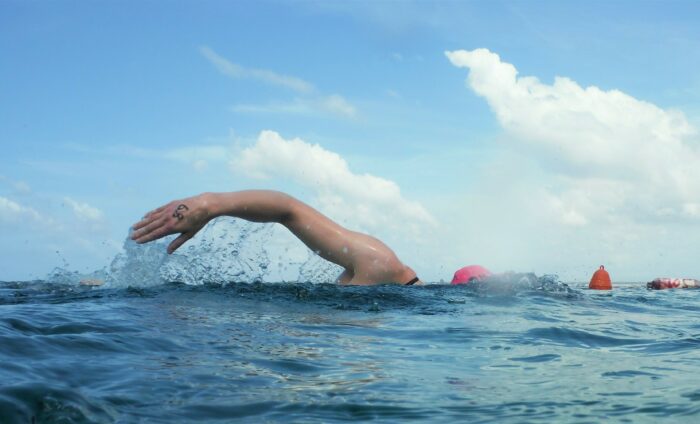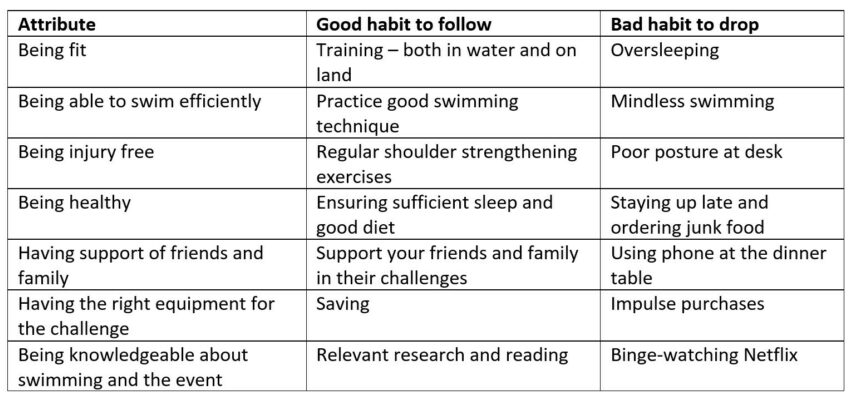
A brief guide to James Clear’s Atomic Habits for outdoor swimmers
In Atomic Habits, James Clear explains how progress in anything is made through the accumulation of small gains. In essence, your habits, how you act day to day, determines where you end up. Atomic Habits is a guide to making it easy to adopt and stick to good habits, and eliminate bad ones.
After reading the book recently, I wondered how you might apply James’s ideas to outdoor swimming.
The underlying principle is that we are defined by our habits. To decide what good habits you should adopt, and which bad habits you should drop, you need a vision of the type of person you want to be. In a swimming context then, you might decide you want to complete a specific challenge in a few months. Instead of jumping straight to what training you need to do in advance of the challenge, instead firstly consider what type of person would be successful and what habits they might follow.
For example, you might identify that a successful swimmer will not only be fit, they will also be injury-free, healthy, have all the kit they need and know how to use it, and will have the support of friends and family. Not only do you need to implement a training habit, you need to cultivate a set of habits to develop the range of attributes required for the challenge. You also need to give up those habits that are working against you. You could perhaps draw up a table as follows:

As you can see, the swim training you do is only part of the picture.
That’s all well and good. We can probably all identify good habits we should adopt and bad habits we should drop. Doing it is harder, which is where Atomic Habits comes in. In it, James sets out a four-step approach to starting and sticking with habits (or stopping and avoiding bad ones). In summary, to stick to a good habit, you need to make it obvious, attractive, easy and satisfying. To drop a bad habit, do the opposite: make it invisible, unattractive, difficult and unsatisfying.
Make it obvious
Imagine you’ve drawn up a training plan that involves three swims per week and one session in the gym. If you don’t already have a training routine, starting and sticking to one can be tricky. It’s easy to forget or book something else. You need to make it more obvious. You could, for example, add your training sessions to your diary, set alarms to ring 30 minutes before a session starts, and print out your training plan and stick it on your fridge door. You now have multiple reminders that you’re training for something. You’ve made it obvious and have put cues in place.
Another technique James shares is “habit stacking”. Once you have one habit ingrained, you can use it as a trigger to stick to a new one. Perhaps you already have a habit of making yourself a coffee every morning. Could you slot in a new habit just before or while the coffee is brewing of doing 10-minutes of shoulder exercises?
If you need cues to remind yourself to swim mindfully, you could write notes to yourself with technique focus points you want to work on and wrap them around your goggles, so you see them before you swim. If you need a reminder in the water, write instructions on the back of your hand.
For the habits you want to drop, you need to make the triggers invisible. Delete Deliveroo from your phone to make it harder to order late-night junk food. If you must have unhealthy snacks in the house, hide them so you don’t see them every time you walk into the kitchen. Even putting a small barrier in place will be enough to prompt you to think twice.
Make it attractive
While swimming itself is enjoyable and attractive, there are always barriers to training. You might have to cycle in the rain or sit in traffic to get there. The journey might be long. You may be swimming early in the morning and struggle to get out of bed. So how can you make doing your training more attractive to help overcome these barriers? James suggests pairing what you need (e.g. getting to training) with something you want (e.g. listening to your favourite music in the car). Have fun with this one and see what you can come up with. It will be personal, but you could, for example, agree to swim with a friend and have coffee with them afterwards. Every time you reward yourself in this way, you reinforce the training habit.
With the habits you want to drop, how you could make them unattractive? How about, every time you oversleep and miss a training session, you make a donation to charity?
Make it satisfying
Making a habit satisfying is the “4th Law” in Atomic Habits. The problem, James explains, is that we evolved in an “immediate reward environment” but we now live in a “delayed reward environment”, and we need to deal with this inconsistency. The rewards of many bad habits are instant, but the ill effects are in the future – for example, junk food satisfies your immediate hunger pangs. In contrast, the rewards of many good habits are long term, but immediate effort is required to do them.
There are parallels here with James’s second law (making the habits you want to follow more attractive) but with a longer-term vision. Rewards are useful to help you start a habit, but for it to truly stick, the habit itself needs to become satisfying. In part, this happens naturally, as the habit – or the impact of the habit – becomes part of your identity. If you swim a lot, you begin to identify yourself as a swimmer, and the need to reinforce the habit through reward disappears.
Another way to make your habits satisfying is through “habit tracking”. For example, if you plot your planned training sessions on a wall chart, and then mark each one off as you do it with a big red tick, you will enjoy seeing the colour spread across the paper and become reluctant to leave gaps.
There’s obviously lots more in Atomic Habits than I have covered here. For example, James writes about accountability partners, making the most of your talents and staying motivated by practising your habits in the “Goldilocks” zone, where the level of difficulty stretches but doesn’t overwhelm you. There’s also a lot more to swimming! However, adopting the right habits will help you become a better swimmer, and the ideas set out in Atomic Habits show a practical way to achieve this.







